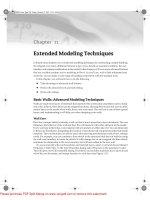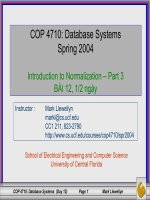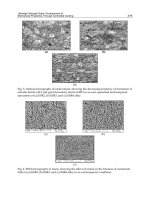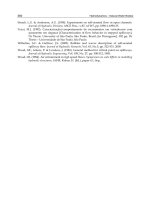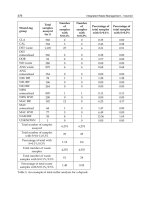Time Delay Systems Part 12 docx
Bạn đang xem bản rút gọn của tài liệu. Xem và tải ngay bản đầy đủ của tài liệu tại đây (385.5 KB, 18 trang )
Masoller, C. (2001). Anticipation in the synchronization of chaotic semiconductor lasers with
optical feedback, Phys. Rev. Lett. 86: 2782–2785.
May, R. M. (1976). Simple mathematical models with very complicated dynamics, Nature
261: 459–467.
Mensour, B. & Longtin, A. (1998). Synchronization of delay-differential equations with
application to private communication, Phys. Lett. A 244: 59–70.
Nakagawa, M. (1999). Chaos and Fractals in Engineering, World Scientific, Singapore.
Nakagawa, M. (2007). Lyapunov spectrum of multidelay feedback systems, (unpublished) .
Namaj
¯
unas, A., Pyragas, K. & Tamaševiˇcius, A. (1995). An electronic analog of the
Mackey-Glass system, Phys. Lett. A 201: 42–46.
Parlitz, U., Chua, L. O., Kocarev, L., Halle, K. S. & Shang, A. (1992). Transmission of digital
signals by chaotic synchronization, Int. J. Bifur. Chaos 2: 973–977.
Parlitz, U., Junge, L. & Kocarev, L. (1996). Synchronization-based parameter estimation from
time series, Phys.Rev.E54: 6253–6259.
Parlitz, U., Kocarev, L., Stojanovski, T. & Preckel, H. (1996). Encoding messages using chaotic
synchronization, Phys.Rev.E52: 4351–4361.
Pecora, L. M. & Carroll, T. L. (1990). Synchronization in chaotic systems, Phys.Rev.Lett.
64: 821–824.
Ponomarenko, V. I. & Prokhorov, M. D. (2002). Extracting information masked by the chaotic
signal of a time-delay system, Phys. Rev. E 66: 026215.1–026215.7.
Prokhorov, M. D., Ponomarenko, V. I., Karavaev, A. S. & Bezruchko, B. P. (2005).
Reconstruction of time-delayed feedback systems from time series, Physica D
203: 209–223.
Pyragas, K. (1998a). Synchronization of coupled time-delay systems: Analytical estimations,
Phys.Rev.E58: 3067–3071.
Pyragas, K. (1998b). Transmission of signals via synchronization of chaotic time-delay
systems, Int. J. Bifur. Chaos 8: 1839–1842.
Rosenblum, M. G., Pikovsky, A. S. & Kurths, J. (1996). Phase synchronization of chaotic
oscillators, Phys.Rev.Lett.76: 1804–1807.
Rosenblum, M. G., Pikovsky, A. S. & Kurths, J. (1997). From phase to lag synchronization in
coupled chaotic oscillators, Phys. Rev. Lett. 78: 4193–4196.
Rossler, O. E. (1976). An equation for continuous chaos, Phys. Lett. A 57: 397–398.
Roy, R. & Thornburg, K. S. (1994). Experimental synchronization of chaotic lasers, Phys. Rev.
Lett. 72: 2009–2012.
Ruelle, D. (1980). Strange attractor, The Mathematical Intelligencer 2: 126–137.
Rulkov, N. F., Sushchik, M. M., Tsimring, L. S. & Abarbanel, H. D. I. (1995). Generalized
synchronization of chaos in directionally coupled chaotic systems, Phys.Rev.E
51: 980–994.
S. Sivaprakasam, P. S. S., Rees, P. & Shore, K. A. (2002). Transition between anticipating and lag
synchronization in chaotic external-cavity laser diodes, Proceedings of SPIE-Volume
4646, pp. 542–546.
Sano, M. & Sawada, Y. (1985). Measurement of lyapunov spectrum from a chaotic time series,
Phys.Rev.Lett.55: 1082–1085.
Sano, S., Uchida, A., Yoshimori, S. & Roy, R. (2007). Dual synchronization of chaos
in Mackey-Gass electronic circuits with time-delayed feedback, Phys.Rev.E
75: 016207.1–016207.6.
209
Recent Progress in Synchronization of Multiple Time Delay Systems
Senthilkumar, D. V. & Lakshmanan, M. (2005). Transition from anticipatory to lag
synchronization via complete synchronization in time-delay systems, Phys.Rev.E
71: 016211.1–016211.10.
Shahverdiev, E. M. (2004). Synchronization in systems with multiple time delays, Phys. Rev. E
70: 067202.1–067202.4.
Shahverdiev, E. M., Nuriev, R. A., Hashimov, R. H. & Shore, K. A. (2005). Parameter
mismatches, variable delay times and synchronization in time-delayed systems,
Chaos, Solitons and Fractals 25: 325–331.
Shahverdiev, E. M. & Shore, K. A. (2005). Generalized synchronization of time-delayed
systems, Phys.Rev.E71: 016201.1–016201.6.
Sharkovskii, A. N. (1964). Coexistence of cycles of a continuous map of a line into
itself(in russian, english summaries), Ukrainskii Mattemacheskii Zhurnal (Ukrainian
Mathemetical Journal) 16: 61–71.
Sharkovskii, A. N. (1995). Coexistence of cycles of a continuous map of a line into itself, Int. J.
Bifur. Chaos 5: 1263–1273.
Stewart, I. (1990). Does God Play Dice?: The Mathematics of Chaos, Blackwell Publisher, Oxford,
UK.
Voss, H. (2002). Real-time anticipation of chaotic states of an electronic circuit, Int. J. Bifur.
Chaos 12: 1619–1625.
Voss, H. & Kurths, J. (1997). Reconstruction of non-linear time delay models from data by the
use of optimal transformations, Phys. Lett. A 234: 336–344.
Voss, H. U. (2000). Anticipating chaotic synchronization, Phys. Rev. E 61: 5115–5119.
Zaikin, A. N. & Zhabotinsky, A. M. (1970). Concentration wave propagation in
two-dimensional liquid-phase self-oscillating system, Nature 225: 535–537.
Zeng, X., Eykholt, R. & Pielke, R. A. (1991). Estimating the lyapunov-exponent spectrum from
short time series of low precision, Phys. Rev. Lett. 66: 3229.
Zhabotinsky, A. M. (1964). Periodic liquid phase reactions, Proceedings of the Academy of
Sciences, USSR, pp. 392–395.
Zhou, C. & Lai, C. H. (1999). Extracting messages masked by chaotic signals of time-delay
systems, Phys.Rev.E60: 320–323.
Zhu, S. & Wu L. (2004). Anticipating and lag synchronization in chaotic laser system, Int. J.
Modern Phys. B 18: 2547–2551.
210
Time-Delay Systems
11
T-S Fuzzy H
∞
Tracking Control of
Input Delayed Robotic Manipulators
Haiping Du
1
and Weihua Li
2
1
School of Electrical, Computer and Telecommunications Engineering
2
School of Mechanical, Materials and Mechatronics Engineering
University of Wollongong, Wollongong, NSW 2522
Australia
1. Introduction
Time delays are often encountered by practical control systems while they are acquiring,
processing, communicating, and sending signals. Time delays may affect the system
stability and degrade the control system performance if they are not properly dealt with.
Taking the classical robot control problem as an example, the significant effect of time delay
on the closed-loop system stability has been highlighted in the bilateral teleoperation, where
the communication delay transmitted through a network medium has been received
widespread attention and different approaches have been proposed to address this problem
(Hokayem and Spong, 2006). In addition, examples like processing delays in visual systems
and communication delay between different computers on a single humanoid robot are also
main sources that may cause time delays in a robotic control system (Chopra, 2009), and the
issue of time delay for robotic systems has been studied through the passivity property.
For systems with time delays, both delay dependent and delay independent control
strategies have been extensively studied in recent years, see for example (Xu and Lam, 2008)
and references therein. For the control of nonlinear time delay systems, model based Takagi-
Sugeno (T-S) fuzzy control (Tanaka and Wang, 2001; Feng, 2006; Lin et al., 2007) is regarded
as one of the most effective approach because some of linear control theory can be applied
directly. Conditions for designing such kinds of controllers are generally expressed as linear
matrix inequalities (LMIs) which can be efficiently solved by using most available software
like Matlab LMI Toolbox, or bilinear matrix inequalities (BMIs) which could be transferred
to LMIs by using algorithms like iteration algorithm or cone complementary linearisation
algorithm. From the theoretical point of view, one of the current focus on the control of time
delay systems is to develop less conservative approaches so that the controller can stabilise
the systems or can achieve the defined control performance under bigger time delays (Chen
et al., 2009; Liu et al., 2010).
Tracking control of robotic manipulators is another important topic which receives
considerable attention due to its significant applications. Over the decades, various
approaches in tracking control of nonlinear systems have been investigated, such as
adaptive control approach, variable structure approach, and feedback linearisation
approach, etc. Fuzzy control technique through T-S fuzzy model approach is also one
Time-Delay Systems
212
effective approach in tracking control of nonlinear systems (Ma and Sun, 2000; Tong et al.,
2002; Lin et al., 2006), and in particular, for robotic systems (Tseng et al., 2001; Begovich et
al., 2002; Ho et al., 2007).
In spite of the significance on tracking control of robotic systems with input time delays, few
studies have been found in the literature up to the date. This chapter attempts to propose an
H
∞
controller design approach for tracking control of robotic manipulators with input
delays. As a robotic manipulator is a highly nonlinear system, to design a controller such
that the tracking performance in the sense of H
∞
norm can be achieved with existing input
time delays, the T-S fuzzy control strategy is applied. Firstly, the nonlinear robotic
manipulator model is represented by a T-S fuzzy model. And then, sufficient conditions for
designing such a controller are derived with taking advantage of the recently proposed
method (Li and Liu, 2009) in constructing a Lyapunov-Krasovskii functional and using a
tighter bounding technology for cross terms and the free weighting matrix approach to
reduce the issue of conservatism. The control objective is to stabilise the control system and
to minimise the H
∞
tracking performance, which is related to the output tracking error for
all bounded reference inputs, subject to input time delays. With appropriate derivation, all
the required conditions are expressed as LMIs. Finally, simulation results on a two-link
manipulator are used to validate the effectiveness of the proposed approach. The main
contributions of this chapter are: 1) to propose an effective controller design method for
tracking control of robotic manipulator with input time delays; 2) to apply advanced
techniques in deriving less conservative conditions for designing the required controller; 3)
to derive the conditions properly so that they can be expressed as LMIs and can be solved
efficiently.
This chapter is organised as follows. In section 2, the problem formulation and some
preliminaries on manipulator model, T-S fuzzy model, and tracking control problem are
introduced. The conditions for designing a fuzzy H
∞
tracking controller are derived in
section 3. In section 4, the simulation results on stability control and tracking control of a
nonlinear two-link robotic manipulator are discussed. Finally, conclusions are summarised
in section 5.
The notation used throughout the paper is fairly standard. For a real symmetric matrix W,
the notation of W >0 (W <0) is used to denote its positive- (negative-) definiteness. . refers
to either the Euclidean vector norm or the induced matrix 2-norm. I is used to denote the
identity matrix of appropriate dimensions. To simplify notation, * is used to represent a
block matrix which is readily inferred by symmetry.
2. Preliminaries and problem statement
2.1 Manipulator dynamics model
To simplify the problem formulation, a two-link robot manipulator as shown in Fig. 1 is
considered.
The dynamic equation of the two-link robot manipulator is expressed as (Tseng, Chen and
Uang, 2001)
M(q)q+V(q,q)q+G(q)=u
(1)
where
T-S Fuzzy H
∞
Tracking Control of Input Delayed Robotic Manipulators
213
2
m
1
m
2
l
1
l
2
q
1
q
Fig. 1. Two-link robotic manipulator.
2
121 1121212
2
212 1 2 1 2 22
2
212 12 1 2
1
1211
22 2
(m +m )l m l l (s s +c c )
M(q)=
mll(ss+cc) ml
0-q
V(q,q)=m l l (c c -s c )
-q 0
-(m +m )l gs
G(q)=
-m l gs
⎡
⎤
⎢
⎥
⎣
⎦
⎡⎤
⎢⎥
⎣⎦
⎡⎤
⎢⎥
⎣⎦
and q=[q
1
,q
2
]
T
and u=[u
1
,u
2
]
T
denote the generalised coordinates (radians) and the control
torques (N-m), respectively. M(q) is the moment of inertia, V(q,
q
) is the centripetal-Coriolis
matrix, and G(q) is the gravitational vector. m
1
and m
2
(in kilograms) are link masses, l
1
and
l
2
(in meters) are link lengths, g=9.8 (m/s
2
) is the acceleration due to gravity, and s
1
=sin (q
1
),
s
2
=sin (q
2
), c
1
=cos (q
1
), and c
2
=cos (q
2
). After defining x
1
=q
1
, x
2
=
1
q , x
3
=
2
q , and x
4
=
2
q ,
equation (1) can be rearranged as
12 1
21 11 1 12 2 2
34 3
42 21 1 22 2 4
x=x w
x=f(x)+
g
(x)u +
g
(x)u w
x=x w
x=f(x)+
g
(x)u +
g
(x)u w
+
+
+
+
(2)
where w
1
, w
2
, w
3
, w
4
denote external disturbances, and
12 12
1
2222
12 1 2 2 1 2 1 2 212 1 2 1 2 2 22 4
2
12 1 2 2 1 2 1 2 1 2 2 1 22 2 1 2 1 2
(s c -c s )
f(x)=
l l [(m +m )-m (s s +c c ) ][m l l [(s s +c c )x -m l x ]
1
l l [(m +m )-m (s s +c c ) ][(m +m )l
g
s-ml
g
s(ss+cc)]
+
Time-Delay Systems
214
12 12
2
222 2
12 1 2 2 1 2 1 2 1 2 1 2 212 1 2 1 2 4
(s c -c s )
f(x)
l l [(m +m )-m (s s +c c ) ][-(m +m )l x +m l l (s s +c c )x ]
=
2
12 1 2 21212 1 2111212 1 212
1
l l [(m +m )-m (s s +c c ) ][-(m +m )l gs (s s +c c )+(m +m )l
g
s]
+
2
22
11
22 2
212 1 2 2 12 1 2
212 1 2 1 2
12
22 2
212 1 2 2 12 1 2
212 1 2 1 2
21
22 2
212 1 2 2 12 1 2
2
121
22
22
212 1 2 2 12
ml
g(x)=
m l l [(m +m )-m (s s +c c ) ]
-m l l (s s +c c )
g(x)=
m l l [(m +m )-m (s s +c c ) ]
-m l l (s s +c c )
g(x)=
m l l [(m +m )-m (s s +c c ) ]
(m +m )l
g(x)=
m l l [(m +m )-m (s s +
2
12
cc)]
Note that the time variable t is omitted in the above equations for brevity.
2.2 T-S fuzzy model
The above described robotic manipulator is a nonlinear system. To deal with the controller
design problem for the nonlinear system, the T-S fuzzy model is employed to represent the
nonlinear system with input delays as follows:
Plant rule i
IF
1
θ (t) is N
i1
, …,
p
θ (t) is N
ip
THEN
ϕ
∈
ii
0
x(t)=A x(t)+B u(t-τ)+Ew(t)
y(t)=Cx(t)
x(0)=x ,u(t)= (t),t [-τ,0],i=1,2, ,k
(3)
where N
ij
is a fuzzy set,
T
1p
θ(t)=[θ (t), ,θ (t)] are the premise variables, x(t) is the state vector,
and w(t) is external disturbance vector, A
i
and B
i
are constant matrices. Scalar k is the
number of IF-THEN rules. It is assumed that the premise control variables do not depend on
the input u(t). The input delay
τ is an unknown constant time-delay, and the constant τ>0 is
an upper bound of
τ
.
Given a pair of (x(t),u(t)), the final output of the fuzzy system is inferred as follows
ϕ
∈
∑
k
iii
i=1
0
x(t)= h (θ(t))(A x(t)+B u(t-τ)+Ew(t))
y(t)=Cx(t)
x(0)=x ,u(t)= (t),t [-τ,0]
(4)
where
∏
∑
p
i
iijijj
k
j=1
i
i=1
μ (θ(t))
h(θ(t))= , μ (θ (t))= N (θ (t))
μ (t))
and
ij j
N(θ (t)) is the degree of the
membership of
j
θ (t) in N
ij
. In this paper, we assume that
ij
μ (θ (t)) 0≥ for i=1,2,…,k and
>
∑
k
i
i=1
μ (θ(t)) 0 for all t. Therefore,
i
h(θ(t)) 0≥ for i=1,2,…,k, and
∑
k
i
i=1
h(θ(t))=1 .
T-S Fuzzy H
∞
Tracking Control of Input Delayed Robotic Manipulators
215
2.1 Tracking control problem
Consider a reference model as follows
rrr
rrr
x (t)=A x (t)+r(t)
y (t)=C x (t)
(5)
where x
r
(t) and r(t) are reference state and energy-bounded reference input vectors,
respectively, A
r
and C
r
are appropriately dimensioned constant matrices. It is assumed that
both x(t) and x
r
(t) are online measurable.
For system model (3) and reference model (5), based on the parallel distributed
compensation (PDC) strategy, the following fuzzy control law is employed to deal with the
output tracking control problem via state feedback.
Control rule
IF
1
θ (t) is N
i1
, …,
p
θ (t) is N
ip
THEN
1i 2i r
u(t)=K x(t)+K x (t), i=1,2, ,k
(6)
Hence, the overall fuzzy control law is represented by
∑∑
kk
i1i2ir ii
i=1 i=1
u(t)= h (θ(t))[K x(t)+K x (t)]= h (θ(t))K x(t) (7)
where K
1i
, and K
2i
, i=1,2,…,k, are the local control gains, and K
i
=[K
1i
, K
2i
] and
TTT
r
x(t)=[x (t),x (t)] . When there exists an input delay τ , we have that
k
i1i2ir
i=1
u(t-τ)= h (θ(t-τ))[K x(t-τ)+K x (t-τ)]
∑
, so, it is natural and necessary to make an
assumption that the functions
i
h(θ(t)) , i=1,2,… ,k, are well defined for all t[-τ,0]∈ , and
satisfy the following properties
i
h(θ(t-τ)) 0≥ for i=1,2,…,k and
i
i=1
h(θ(t-τ)) 1
k
=
∑
. For
convenience, let
ii
h=h(θ(t)) ,
ii
h(τ)=h (θ(t-τ)) , x(τ)=x(t-τ) , and u(τ)=u(t-τ) . From here, unless
confusion arises, time variable t will be omitted again for notational convenience.
With the control law (7), the augmented closed-loop system can be expressed as follows
k
ij i ij
i,j=1
x= h h (τ)[A x+B x(τ)+Ev]
e=Cx
∑
(8)
where
[]
ii1ji2ji
ii
j
1
j
2
j
i
j
rr
r
A0 BKBK B E0 w
ˆ
A = ,B = = [K K ]=B K ,E= ,C= C -C ,v= ,e=
y
-
y
0A 0 0 0 0I r
⎡⎤⎡ ⎤⎡⎤ ⎡⎤ ⎡⎤
⎢⎥⎢ ⎥⎢⎥ ⎢⎥ ⎢⎥
⎣⎦⎣ ⎦⎣⎦ ⎣⎦ ⎣⎦
.
The tracking requirements are expressed as follows
1.
The augmented closed-loop system in (8) with v=0 is asymptotically stable;
2.
The H
∞
tracking performance related to tracking error e is attenuated below a desired
level, i.e., it is required that
Time-Delay Systems
216
22
e<γ v (9)
for all nonzero
2
vL[0,)
∈
∞ under zero initial condition, where γ>0 .
Our purpose is to find the feedback gains K
i
(i=1,2,…,k) such that the above mentioned two
requirements are met.
3. Tracking controller design
To derive the conditions for designing the required controller, the following lemma will be
used.
Lemma 1: (Li and Liu, 2009) For any constant matrices
11
S0≥ ,
12
S ,
22
S0≥ ,
11 12
22
SS
0
*S
⎡⎤
≥
⎢⎥
⎣⎦
,
scalar
ττ≤ and vector function
n
x:[-τ,0] R→
such that the following integration is well
defined, then
T
T
22 22 12
t
11 12
TT T
22 22 12
t-τ
22
tt
12 12 11
t-τ t-τ
x-SS-S x
SS
x(s)
-τ [x (s),x (s)] x(τ)S-SS x(τ)
*S
x(s)
-S S -S
x(s)ds x(s)ds
⎡
⎤⎡⎤
⎡⎤
⎢
⎥⎢⎥
⎡⎤
⎡⎤
⎢⎥
⎢
⎥⎢⎥
≤
⎢⎥
⎢⎥
⎢⎥
⎢
⎥⎢⎥
⎣⎦
⎣⎦
⎢⎥
⎢
⎥⎢⎥
⎣⎦
⎣
⎦⎣⎦
∫
∫∫
(10)
We now choose a delay-dependent Lyapunov-Krasovksii functional candidate as
t
TT
t-τ
V=x Px+τ (s-(t-τ)η (s)Sη(s)ds
∫
(11)
where
⎡
⎤⎡⎤
⎡⎤
⎢
⎥⎢⎥
⎣⎦
⎣
⎦⎣⎦
T
11 12 11 12
TT
11 22
22 22
SS SS
η(s)= x (s),x (s) , P>0, S= , S >0, S >0, >0
*S *S
.
The derivative of V along the trajectory of (8) satisfies
t
T2T T
t-τ
V=2x Px+τηSη-τη(s)Sη(s)ds
∫
(12)
If follows from (8) that
k
TT T T
1234 ijiij
i,j=1
0=2[x T +x (τ)T +x T +d v ] h h (τ)[A x+B x(τ)+Ev]-x
⎛⎞
⎜⎟
⎜⎟
⎝⎠
∑
(13)
i.e.,
1
k
2
TT TT
ij i ij
i,j=1
3
4
Tx
Tx(τ)
0=2 h h (τ)[ x x (τ)x v] A B -IE
Tx
dI v
⎡
⎤⎡⎤
⎢
⎥⎢⎥
⎢
⎥⎢⎥
⎡⎤
⎣⎦
⎢
⎥⎢⎥
⎢
⎥⎢⎥
⎣
⎦⎣⎦
∑
T-S Fuzzy H
∞
Tracking Control of Input Delayed Robotic Manipulators
217
1i 1ij 1 1
2i 2ij 2 2
3i 3ij 3 3
k
4i 4ij 4 4
TT TT
ij
i,j=1
1i 1ij 1 1
2i 2ij 2 2
3i 3ij 3 3
4i 4ij 4 4
TA TB -T TE
TA TB -T TE
TA TB -T TE
dA dB -dI dE
hh(τ)[ x x (τ)x v]
TA TB -T TE
TA TB -T TE
TA TB -T TE
dA dB -dI dE
T
⎛⎞
⎡⎤
⎜⎟
⎢⎥
⎜⎟
⎢⎥
⎜
⎢⎥
⎜
⎢⎥
⎜
⎢⎥
⎣⎦
⎜
=
⎜
⎡⎤
⎜
⎢⎥
⎜
⎢⎥
⎜
+
⎢⎥
⎜
⎢⎥
⎜
⎢⎥
⎜
⎣⎦
⎝⎠
∑
x
x(τ)
x
v
⎟
⎟
⎡
⎤
⎟
⎢
⎥
⎟
⎢
⎥
⎟
⎢
⎥
⎟
⎢
⎥
⎟
⎣
⎦
⎟
⎟
⎟
⎟
(14)
where T
1
, T
2
, and T
3
are constant matrices, and d
4
is a constant scalar. Note that d
4
is
introduced as a scalar not a matrix because it is convenient to get the LMI conditions later.
Using the above given equality (14) and Lemma 1, and adding two sides of (12) by
T2T
ee-γ v v , it is obtained that
11 12
T2T T TT T2T
22
T
T
22 22 12
T
22 22 12
tt
12 12 11
t-τ t-τ
1
k
2
TT TT
ij
i,j=1
x
SS
V+e e-γ vv 2xPx+τ[x ,x ] +e e-γ vv
*S
x
x-SS-S x
+x(τ)S-SS x(τ)
-S S -S
x(s)ds x(s)ds
T
T
2hh(τ)[ x x (τ)x v]
⎡⎤
⎡⎤
≤
⎢⎥
⎢⎥
⎣⎦
⎣⎦
⎡⎤ ⎡⎤
⎡⎤
⎢⎥ ⎢⎥
⎢⎥
⎢⎥ ⎢⎥
⎢⎥
⎢⎥ ⎢⎥
⎢⎥
⎢⎥ ⎢⎥
⎣⎦
⎣⎦ ⎣⎦
+
∫∫
∑
iij
3
4
k
T
ij ij
i,j=1
x
x(τ)
AB-IE
T
x
dI
v
hh(τ)ξΣξ
⎡
⎤
⎡⎤
⎢
⎥
⎢⎥
⎢
⎥
⎢⎥
⎡⎤
⎣⎦
⎢
⎥
⎢⎥
⎢
⎥
⎢⎥
⎢
⎥
⎣⎦
⎣
⎦
=
∑
(15)
where
(
)
T
t
TTT TT
t-τ
ξ =x x(τ)x(s)dsxv
⎡⎤
⎢⎥
⎣⎦
∫
and
2
2
22 1 ij
12
11 22 1 i
TT
12 1 4 i
TT
TT T
TT
1i3
i1
i2
22 2 ij
TTT T
12 2 i
j
324i
j
TT
ij 2
ij
11
2
22 3
34
T
3
T
44
2
S+TB
P+τ S
τ S-S+TA
-S T E+d A
-T +A T
+A T +C C
+A T
-S +T B
*S-T+BTTE+dB
+B T
=
**-S00
τ S-T
*** TE-dI
-T
dE+dE
****
-γ I
⎡
⎤
⎢
⎥
⎢
⎥
⎢
⎥
⎢
⎥
⎢
⎥
⎢
⎥
⎢
⎥
Σ
⎢
⎥
⎢
⎥
⎢
⎥
⎢
⎥
⎢
⎥
⎢
⎥
⎢
⎥
⎣
⎦
(16)
Time-Delay Systems
218
It can be seen from (15) that if
ij
0
Σ
< , then
T2T
V+e e-γ vv<0
can be deduced and therefore
22
e<γ v can be established with the zero initial condition. When the disturbance is zero,
i.e.,
v=0, it can be inferred from (15) that if
ij
0
Ξ
< , then
V<0
, and the closed-loop system
(8) is asymptotically stable.
By denoting T
2
=d
2
T
1
,T
3
=d
3
T
1
, where d
2
and d
3
are given constants, pre and post-multiplying
both side of (16) with diag[Q, Q, Q, I, Q] and their transpose, defining new variables
-1
1
Q=T ,
T
11 11
S=QSQ,
T
12 12
S=QSQ,
T
22 22
S=QSQ,
T
P=QPQ , and
T
jj
K=KQ ,
ij
0
Σ
< is equivalent to
⎡⎤
⎢⎥
⎢⎥
⎢⎥
⎢⎥
⎢⎥
⎢⎥
⎢⎥
⎢
⎢
⎢
⎢
⎢
⎢
⎢
⎢
⎣⎦
2T 2
22 i j
11 22 i 12
TT
12 4 i
TTT T T
T
i3i
2i
TT
22 2 i j
3ji
TTT
12 2 4 j i
TT
T
2ji
2
11
2
22 3
34
T
3
T
44
2
ˆ
S+BK
τ S-S+AQ P+τ S
-S E+d QA
+QA +QC CQ -Q +d QA
+d QA
ˆ
ˆ
-S +d B K
dKB
ˆ
*SdE+dKB
ˆ
+d K B
-d Q
**-S00
τ S-dQ
*** dE-dQ
-d Q
dE+dE
****
-γ I
<
⎥
⎥
⎥
⎥
⎥
⎥
⎥
⎥
0
(17)
which is further equivalent to
ij
0
Ξ
< by the Schur complement, where
⎡
⎢
⎢
⎢
⎢
⎢
⎢
⎢
⎢
Ξ
⎢
⎢
⎢
⎢
⎢
⎣
22
22 i j
11 22 12
TTT
12 4 i
TT T T
T
ii 3i
2i
TT
22 2 i j
3ji
TTT
12 2 4 j i
TT
T
2ji
2
11
ij
2
22 3
34
T
3
T
44
2
ˆ
S+BK
τ S-S P+τ S
-S E+d QA QC
+A Q +QA -Q +d QA
+d QA
ˆ
ˆ
-S +d B K
dKB
ˆ
*SdE+dKB0
ˆ
+d K B
-d Q
**-S000
=
τ S-dQ
*** dE-dQ0
-d Q
dE+dE
**** 0
-γ I
*****-I
⎤
⎥
⎥
⎥
⎥
⎥
⎥
⎥
⎥
⎥
⎥
⎥
⎥
⎥
⎢⎥
⎢⎥
⎢⎥
⎦
(18)
In terms of the above given analysis, we now summarise the proposed tracking controller
design procedure as:
i.
define value for τ and choose appropriate values for d
2
, d
3
, and d
4
.
ii.
solve the following LMIs
ii
0
Ξ
< (19)
ij ji
0
Ξ
+Ξ < (20)
T-S Fuzzy H
∞
Tracking Control of Input Delayed Robotic Manipulators
219
11 12
22
SS
0
*S
⎡⎤
≥
⎢⎥
⎢⎥
⎣⎦
(21)
If there exist
P>0
,
11
S0> ,
22
S0> and real matrices Q,
12
S,
j
K (j=1, k) satisfying LMIs (19-
21), then the closed-loop system (8) is asymptotically stable for any
0 ττ
≤
≤ and the
tracking performance defined in (9) can be achieved.
iii.
obtain the control gain matrices as
T-1
jj
K=K(Q ) (22)
4. Numerical example
This section takes two-link robotic manipulator as an example and evaluates the proposed
controller design approach through numerical simulations. In the reference (Tseng, Chen
and Uang, 2001), the T-S fuzzy model with nine rules is used to represent the original
nonlinear manipulator system with acceptable accuracy when link masses m
1
=m
2
=1 (kg),
link lengths l
1
=l
2
=1 (m), and angular positions are constrained within [ - π/2 , π/2 ] , where
triangle type membership functions are used for all the rules.
To show the effectiveness of the proposed controller design method, the stability control of
the robotic manipulator with and without input delays is firstly evaluated. For comparison
purpose, we introduce a so-called robust controller from (Sun, et al., 2007), which was
designed using a region based rule reduction approach and obtained with one rule to
reduce the complexity caused by the number of fuzzy rules. The design result for this
controller with a decay rate 0.5 was given as
-115.6439 -49.9782 -13.4219 -3.7453
K=
14.6547 -3.4203 -62.7788 -22.1846
⎡
⎤
⎢
⎥
⎣
⎦
(23)
The simulation results for the nonlinear model (1) with initial condition x(0)=[1.2,0,-1.2,0]
T
and controller (23) without input delays are shown in Fig. 2.
It is seen from Fig. 2 that all the state variables converge to the equilibrium states from initial
conditions quickly. We now introduce input delays to the two control inputs. As an
example, input delays for both control inputs are given as 24 ms, and the simulation results
for all state variables are shown in Fig. 3.
It is observed that the state variables do not converge to equilibrium states in this case and
hence controller (23) is not able to stabilise the system when input time delays are given as
24 ms.
Following the similar idea given in (Sun, et al., 2007), a robust controller which uses only
one rule and considers the fuzzy model as a polytopic uncertain model can also be designed
using the presented conditions (19-21). We now use the reference model as
r
010 0
-6 -5 0 0
A=
000 1
00 6 5
⎡
⎤
⎢
⎥
⎢
⎥
⎢
⎥
⎢
⎥
−
−
⎣
⎦
,
Time-Delay Systems
220
0 0.5 1 1.5 2 2.5 3 3.5 4 4.5 5
-3
-2
-1
0
1
2
3
Time (s)
States
x1
x2
x3
x4
Fig. 2. State responses for controller (23) without input delays.
0 0.5 1 1.5 2 2.5 3 3.5 4 4.5 5
-15
-10
-5
0
5
10
15
Time (s)
States
x1
x2
x3
x4
Fig. 3. State responses for controller (23) with input delay as 24 ms.
T-S Fuzzy H
∞
Tracking Control of Input Delayed Robotic Manipulators
221
choose τ =30 ms, d
2
=0.1, d
3
=0.1, d
4
=0.1, and define
10000-100 0 0
C=
0 0 10 0 0 0 10 0
⎡
⎤
⎢
⎥
−
⎣
⎦
,
which aims on reducing tracking errors on state variables x
1
and x
3
, the LMIs (19-21) are
feasible to find a solution, and the controller gain matrix is obtained as
-52.5581 -14.8674 0.7159 -0.0785 33.3479 5.8168 -5.0603 -0.6409
K=
-0.6312 -0.5382 -31.8608 -8.5689 -1.9704 -0.2084 22.7118 3.7215
⎡⎤
⎢⎥
⎣⎦
(24)
To check the stability control performance of the designed controller (24), the reference
input and external disturbances are all set as zero, and the initial conditions are same to the
above used values. The simulation results with controller (24) are now shown in Fig. 4 when
input delays are given as 30 ms.
0 0.5 1 1.5 2 2.5 3 3.5 4 4.5 5
-2.5
-2
-1.5
-1
-0.5
0
0.5
1
1.5
2
2.5
Time (s)
States
x1
x2
x3
x4
Fig. 4. State responses for controller (24) with input delays as 30 ms.
It is seen from Fig. 4 that all the state variables converge to equilibrium states no matter the
existence of the input time delays, which shows the effectiveness of the designed controller
(24) when the input time delays are considered in the controller design procedure.
As controller (24) is designed using the tracking controller design conditions (19-21), its
tracking control performance can be checked as well when the reference inputs are
provided. As those done in (Tseng, Chen and Uang, 2001), we define reference input as
[]
r(t)= 0, 8sin(t), 0, 8cos(t)
T
and to validate its robustness, the external disturbances are given
Time-Delay Systems
222
as w
1
=0.1sin(2t), w
2
=0.1cos(2t), w
3
=0.1cos(2t), and w
4
=0.1sin(2t). The initial condition is
assumed to be [x
1
(0),x
2
(0),x
3
(0),x
4
(0)]
T
=[0.5, 0, -0.5, 0]
T
, and the input time delays are
assumed to be 30 ms. Under these conditions, the simulation responses for both the
reference state variables and actual state variables are shown in Fig. 5 for x
1
(left) and x
3
(right), respectively. From Fig. 5, it is observed that the actual state variables are able to
track the reference state variables although there is a big difference at the beginning due to
different initial values. It proves that the designed controller (24), in spite of its simplicity in
structure, can stabilise the nonlinear manipulator system and can basically track the
reference state variables.
0 2 4 6 8 10 12 14 16 18 20
-1.5
-1
-0.5
0
0.5
1
1.5
Time (s)
State variable x
1
0 2 4 6 8 10 12 14 16 18 20
-1.5
-1
-0.5
0
0.5
1
1.5
Time (s)
State variable x
3
Actual state variable
Reference state variable
Actual state variable
Reference state variable
Fig. 5. State responses for the designed controller (24) with input delays as 30 ms.
Nevertheless, from Fig. 5, it is also seen that the tracking performance is not really desirable
as the differences between the reference state variables and the actual state variables can be
easily identified, in particular, for state variable x
1
(left). The poor tracking performance
realised by controller (24) comes from the reasons that it is one rule based controller and
therefore it is weak in achieving good performance for the original model which is
approximated with nine rules.
We now design a fuzzy tracking controller through PDC strategy by using the proposed
approach. Using the same parameter values for
τ , d
2
, d
3
, d
4
, and C , the LMIs (19-21) are
feasible to find a solution, and the controller gain matrices for nine rules are given as
T-S Fuzzy H
∞
Tracking Control of Input Delayed Robotic Manipulators
223
1
-115.9265 -19.4020 -51.6975 -9.0525 101.1323 12.6747 45.3281 5.8894
K=
-53.0984 -9.4817 -58.7058 -9.9765 48.3992 6.1958 51.9449 6.5429
⎡ ⎤
⎢ ⎥
⎣ ⎦
2
-141.9683 -23.5791 0.2777 -0.3129 124.8768 15.4512 -2.2731 0.0976
K=
-3.4846 -0.5815 -88.7399 -14.9675 0.2146 0.2869 80.2204 9.8727
⎡⎤
⎢⎥
⎣⎦
3
-115.5704 -19.0475 55.4697 9.1381 102.6000 12.5192 -52.2332 -6.1268
K=
54.2377 9.4285 -55.4358 -9.5060 -51.7672 -6.2518 52.6118 6.3387
⎡ ⎤
⎢ ⎥
⎣ ⎦
4
-146.4229 -23.9600 0.6201 -0.1205 126.9068 15.6729 -3.3843 -0.0513
K=
1.2587 -0.3380 -90.8831 -15.0851 -0.9041 0.1750 80.8721 9.9366
⎡⎤
⎢⎥
⎣⎦
5
-121.6095 -19.5529 -50.2643 -8.9250 101.9231 12.7272 44.6201 5.8019
K=
-51.8299 -9.3220 -62.0814 -10.0800 47.5336 6.0782 52.4858 6.5645
⎡ ⎤
⎢ ⎥
⎣ ⎦
6
-145.5178 -23.8434 -0.1544 -0.2041 126.2843 15.5980 -2.9193 0.0002
K=
0.3571 -0.4417 -90.2942 -15.0410 -0.5286 0.2197 80.6263 9.9110
⎡⎤
⎢⎥
⎣⎦
7
-115.6616 -19.0441 55.1637 9.1441 102.6047 12.5166 -52.2722 -6.1372
K=
54.5435 9.4487 -55.3558 -9.5095 -51.7828 -6.2513 52.6340 6.3439
⎡ ⎤
⎢ ⎥
⎣ ⎦
8
-142.5607 -23.6137 0.4674 -0.2926 125.0556 15.4695 -2.3887 0.0840
K=
-2.8051 -0.5295 -89.1068 -14.9940 0.1127 0.2772 80.3652 9.8887
⎡⎤
⎢⎥
⎣⎦
9
-116.9415 -19.5309 -50.5115 -8.8252 101.8508 12.7564 44.0836 5.7350
K=
-52.3753 -9.3980 -59.5804 -10.1199 47.9301 6.1423 52.7279 6.6383
⎡ ⎤
⎢ ⎥
⎣ ⎦
The tracking performance implemented by this fuzzy controller is shown in Fig. 6. It can be
seen that the differences between the reference state variables and the actual state variables
are largely reduced for both state variables. The tracking performance is therefore improved
even with the existence of input time delays.
It is noted that in the proposed controller design approach, several parameters like d
2
, d
3
,
and d
4
, need to be defined before starting to solve the LMIs. These parameters could be
optimised in terms of the tolerable maximum input delays
τ
, tracking performance
γ
, and
feasible solutions to LMIs (19-21), etc. The weights on matrix
C
will also play an important
role in obtaining a good tracking performance. Higher weight value on one state variable
will generally result in a controller which can reduce the tracking error on this state variable
in comparison to other variables. However, these parameters need to be considered
altogether and some possible optimisation algorithms, such as genetic algorithms (GAs),
could be used to find the sub-optimal parameters, which, however, is beyond the scope of
this chapter, and will not be further discussed.
Time-Delay Systems
224
0 2 4 6 8 10 12 14 16 18 20
-1.5
-1
-0.5
0
0.5
1
1.5
Time (s)
State variable x
1
0 2 4 6 8 10 12 14 16 18 20
-1.5
-1
-0.5
0
0.5
1
1.5
Time (s)
State variable x
3
Actual state variable
Reference state variable
Actual state variable
Reference state variable
Fig. 6. State responses for the proposed fuzzy tracking controller with input delays as 30 ms.
5. Conclusions
In this chapter, the tracking control problem for a robotic manipulator with input time
delays is studied. To deal with the nonlinear dynamics of robotic manipulator, the T-S fuzzy
control strategy is applied. To reduce the conservativeness in deriving conditions for
designing such a tracking controller, the most advanced techniques in defining Lyapunov-
Krasovskii functional and in solving cross terms are used. To achieve good tracking
performance, the tracking error in the sense of H
∞
norm is minimised. The sufficient
conditions are derived as delay-dependent LMIs, which can be solved efficiently using
currently available software like Matlab LMI Toolbox. The solution is also dependent to the
values of d2, d3, d4, and the weights on matrix
C , which may further provide the space to
improve the performance of the designed controller. Numerical simulations are applied to
validate the performance of the proposed approach. The results show that the designed
controller can achieve good tracking performance regardless of the existence of input time
T-S Fuzzy H
∞
Tracking Control of Input Delayed Robotic Manipulators
225
delays. This topic is going to be further studied with considering modelling errors,
parameter uncertainties, and actuator saturations.
6. References
Begovich, O., Sanchez, E. N. and Maldonado, M. (2002). Takagi-Sugeno fuzzy scheme for
real-time trajectory tracking of an underactuated robot,
IEEE Transactions on Control
Systems Technology
, Vol. 10, No. 1, 14-20
Lin, C., Wang, Q. G. and Lee, T. H. (2007).
LMI Approach to Analysis and Control of Takagi-
Sugeno Fuzzy Systems with Time Delay
, Springer, New York.
Chen, B., Liu, X., Lin, C. and Liu, K. (2009). Robust H
∞
control of Takagi-Sugeno
fuzzy systems with state and input time delays,
Fuzzy Sets and Systems, Vol. 160,
403-422
Chopra, N. (2009). Control of robotic manipulators with input/output delays, Proceedings
of the American Control Conference, St. Louis, MO, USA, 2024-2029
Feng, G. (2006). A survey on analysis and design of model-based fuzzy control systems,
IEEE Transactions on Fuzzy Systems, Vol. 14, No. 5, 676-697
Ho, H. F., Wong, Y. K. and Rad, A. B. (2007). Robust fuzzy tracking control for robotic
manipulators, Simulation Modelling Practice and Theory, Vol. 15, 801-816
Hokayem, P. F. and Spong, M. W. (2006). Bilateral teleoperation: An historical survey,
Automatica, Vol. 42, 2035-2057
Li, L. and Liu, X. (2009). New results on delay-dependent robust stability criteria of
uncertain fuzzy systems with state and input delays, Information Sciences, Vol.
179, 1134-1148.
Lin, C., Wang, Q G. and Lee, T. H. (2006). H
∞
output tracking control for nonlinear systems
via T-S fuzzy model approach, IEEE Transactions on Systems, Man and
Cybernetics—Part B: Cybernetics, Vol. 36, No. 2, 450-457
Liu, F., Wu, M., He, Y. and Yokoyama, R. (2010). New delay-dependent stability criteria for
T-S fuzzy systems with time-varying delay, Fuzzy Sets and Systems, Vol. 161, 2033-
2042.
Ma, X J. and Sun, Z Q. (2000). Output tracking and regulation of nonlinear system based
on Takagi-Sugeno fuzzy model, IEEE Transactions on Systems, Man and
Cybernetics—Part B: Cybernetics, Vol. 30, No. 1, 47-59
Sun, C C., Wu, S M., Chung, H Y. and Chang, W J. (2007). Design of Takagi-Sugeno fuzzy
region controller based on rule reduction, robust control, and switching concept,
Journal of Dynamic Systems, Measurement, and Control, Vol. 129, 163-170
Tanaka, K. andWang, H. O. (2001). Fuzzy control systems design and analysis: A linear
matrix inequality approach, John Wiley & Sons, Inc., New York
Tong, S., Wang, T. and Li, H X. (2002). Fuzzy robust tracking control for
uncertain nonlinear systems, International Journal of Approximate Reasoning, Vol.
30, 73-90
Tseng, C S., Chen, B S. and Uang, H J. (2001). Fuzzy tracking control design for nonlinear
dynamic systems via T-S fuzzy model, IEEE Transactions on Fuzzy Systems, Vol. 9,
No. 3, 381-392
Time-Delay Systems
226
Xu, S. and Lam, J. (2008). A survey of linear matrix inequality techniques in stability analysis
of delay systems, International Journal of Systems Science, Vol. 39, 1095-1113
